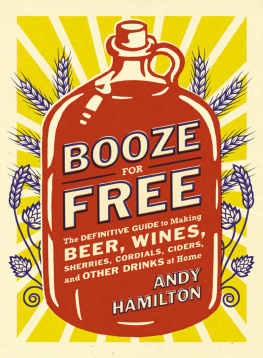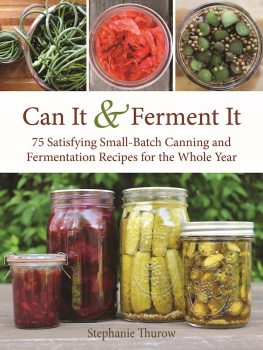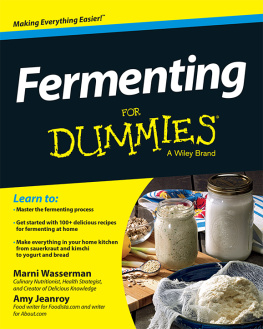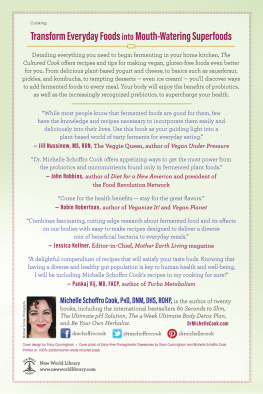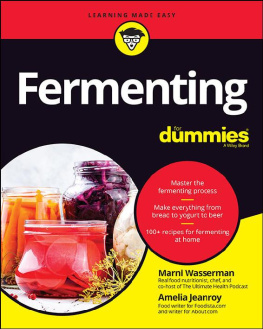Contents
Guide
Page List
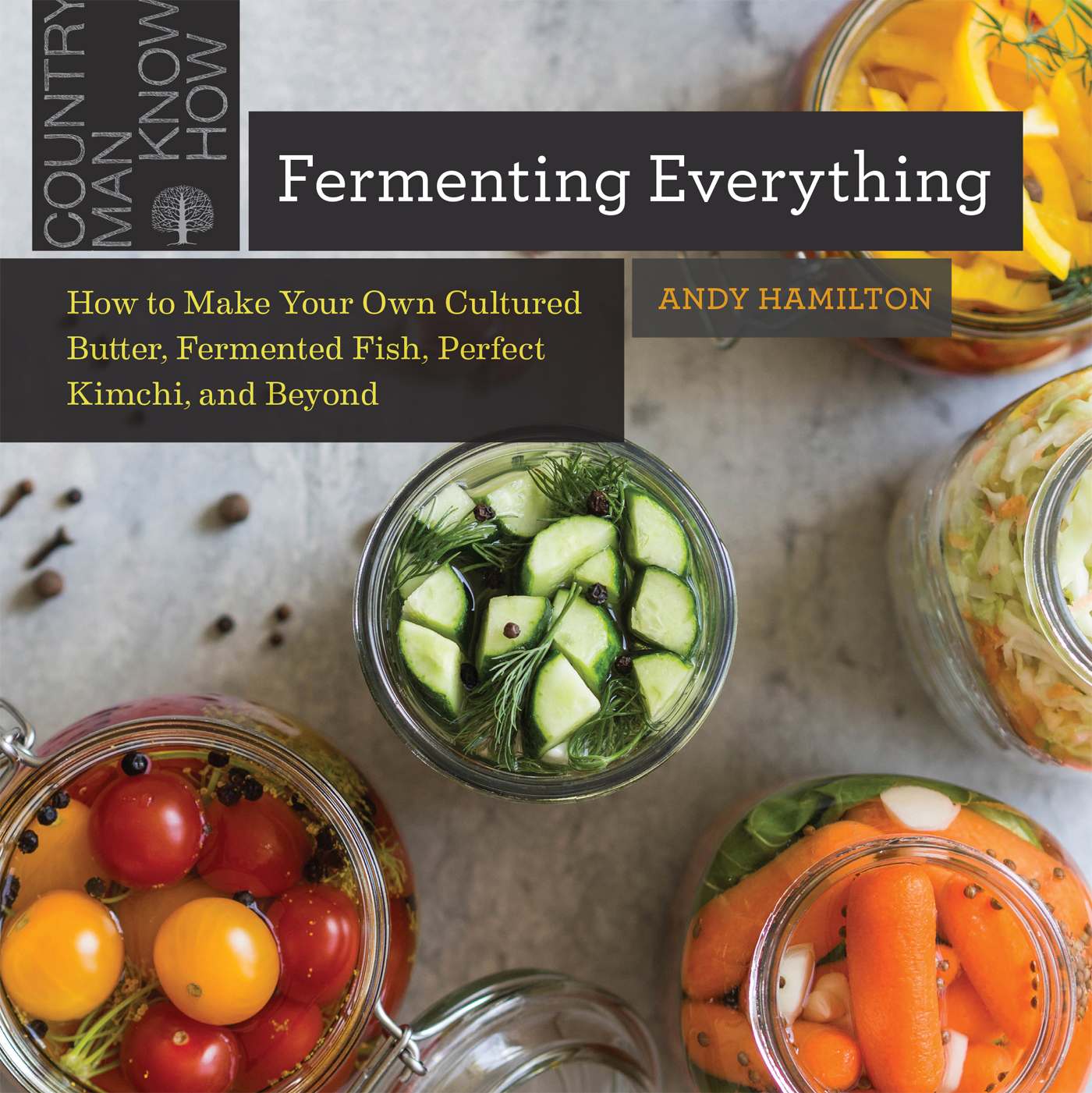
Fermenting Everything
How to Make Your Own Cultured Butter, Fermented Fish, Perfect Kimchi, and Beyond
ANDY HAMILTON


This volume is intended as a general information resource. Fermenting at home carries certain risks, including contamination of foods and beverages from inadequate cleaning or sanitization of equipment, allergic reactions to ingredients, and use of poisonous plants and leaves. See the Authors Note for a more detailed list of the risks and how to minimize them. This book is not a substitute for advice from a physician or dietician. Before incorporating fermented foods into your diet, especially if you are pregnant or nursing, consult your healthcare provider.
As of press time, the URLs displayed in this book link or refer to existing websites. The publisher is not responsible for, and should not be deemed to endorse or recommend, any website other than its own or any content not created by it; nor is the author responsible for any third-party material in any form.
Copyright 2020 by Andy Hamilton
Photos copyright 2020 by Roy Hunt
The recipe for Beet Kvass was originally published in The Kitchn and is reprinted by permission of Emily Han.
Photos by Roy Hunt unless stated otherwise below:
: gabrielasauciuc/iStockphoto.com
All rights reserved
For information about permission to reproduce selections from this book, write to Permissions, The Countryman Press, 500 Fifth Avenue, New York, NY 10110
For information about special discounts for bulk purchases, please contact W. W. Norton Special Sales at specialsales@wwnorton.com or 800-233-4830
SERIES COVER DESIGN: Nick Caruso Design
COVER PHOTOGRAPH Olga Peshkova/iStockPhoto.com
AUTHOR PHOTOGRAPH Royston Hunt
Series book design by Nick Caruso Design
Production manager: Devon Zahn
The Library of Congress has cataloged the printed edition as follows:
Names: Hamilton, Andy, 1974 author.
Title: Fermenting everything : how to make your own cultured butter, fermented fish, perfect kimchi, and beyond / Andy Hamilton.
Description: First edition. | New York, NY : The Countryman Press, a division of W. W. Norton & Company Independent Publishers since 1923, [2020] | Series: Countryman know-how | Includes index.
Identifiers: LCCN 2019058901 | ISBN 9781682684696 (paperback) | ISBN 9781682684702 (epub)
Subjects: LCSH: Fermented foods. | Fermentation. | LCGFT: Cookbooks.
Classification: LCC TP371.44 .H3525 2020 | DDC 664/.024dc23
LC record available at https://lccn.loc.gov/2019058901
The Countryman Press
www.countrymanpress.com
A division of W. W. Norton & Company, Inc.
500 Fifth Avenue, New York, NY 10110
www.wwnorton.com
dedication
To my Emma, I dont know why it took five books
for you to get a dedication, but here it is.
Authors note
On the following pages you will discover the joy I found in fermenting all kinds of food. Im very happy to share this joy with everyonealong with my knowledge and experience. But, as I explain at various points in the text, you need to be always aware of certain safety risks and requirements.
Consuming fermented foods: Be careful introducing fermented foods and beverages into your diet. If you are pregnant or nursing or on prescription medication, or if you suffer from any kind of abdominal illness, ask your doctor before you do so. And even if you dont fall into any of those categories, if you find yourself reacting negatively to any fermented product, stop consuming it.
Foraging: To obtain some ingredients for some of these recipes, I recommend foraging. But before you do any foraging, make sure you know what you are looking for and make sure you can recognize poisonous plants and leaves, for example, by reading a field guide that covers your locality or by taking a foraging hike with an expert. Do not use anything you find foraging as an ingredient unless you are absolutely sure is okay to ingest.
Mold and mothers
Fermentation involves growing and harnessing microbes. If we get it wrong, we may end up growing the wrong microbes: pathogenic ones that can cause illness. The fermentation process can also produce mold. Both mold and pathogens are dangerous to consume. If you do ingest them as part of your fermented creation, you can get really sick. You also may get sick if mold sticks to the dishware and glassware that you are using.
You should be able to avoid growing mold or pathogens if you:
Follow the procedures in each recipe to the letter.
Keep your equipment clean (see below Cleaning and sanitizing).
Do not ferment close to active mold spores.
Keep the food submerged below the waterline.
Use the right levels of salt or yeast indicated by the recipe.
How can you spot mold if it does grow despite your best efforts? Mold can be white, black, brown, grey, blue, green, yellow, pink, purple, and/or orange. It grows in dark damp areas.
Note: Not every white growth is mold. If your creation includes vinegar or kombucha, a white layer that resembles some kind of glue may form on it. That is the start of a mother forming, which is a semisolid jelly-like substance that is composed of a form of cellulose and acetic acid bacteria and that develops on fermenting alcoholic liquids and turns alcohol into acetic acid. You dont need to throw out your creation if you see a mother. What youre seeing also could be harmless yeast, so refer to the photo of kahm yeast on before you do anything rash.
But as a general rule, if you see anything in or on any of your creations that you are not sure is safe, throw the whole thing out.
Cleaning and sanitizing
With many forms of fermentation that I describe in this book, thorough cleaning in a hot dishwasher is usually enough to avoid having mold contaminate your glassware and dishware. But when you are fermenting beverages, the only way to minimize the risk of contamination is by properly sanitizing your equipment at the start and at each step along the way. For that purpose, you can use bleach or other sanitizers, but the sanitizing solution I recommend is an acid-based, no-rinse brand called Star San.
If, however, despite your best sanitizing efforts, you do see mold in or on one of your creations, again, throw it out immediately.
Ingredients
Allergies: If youre fermenting something for yourself, obviously you shouldnt include any ingredient to which you know youre allergic. If youre making something for friends or others, be sure not to serve any product that includes something to which someone else might be allergic, including lactose to someone with a dairy allergy or any product with gluten to someone who is allergic to gluten.
Freshness: Examine apples and other fresh ingredients to make sure they are not stale. Make sure bottled juice or any other packaged ingredient is not past its sale date.
Exploding bottles: You may have heard people talk about exploding home-brew bottles, but the risk of this happening is really, really small as long as you follow the sugar measurements given in the recipes. (To generate an explosion would require exceeding the sugar recommendations by roughly three times the directed amounts.) Also, since such explosions are caused by pressure built up over time, even if there is an explosion, it wont happen while youre actually brewing. It will happen while the brew is being stored. So store your brew bottles in a closed space to lessen the possibility of damage or injury from flying glass if an explosion does occur. Storage in a fridge or a cool store room/cellar will also lower your chances of explosions, since cold temperatures slow down the amount of co2 produced that causes explosions.


